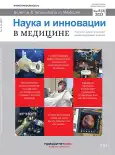Морфологические особенности щитовидной железы крыс после нанесения дефекта в большеберцовых костях
- Авторы: Морозов В.Н.1
-
Учреждения:
- ФГАОУ ВО «Белгородский государственный национальный исследовательский университет» Министерства высшего образования и науки РФ
- Выпуск: Том 8, № 3 (2023)
- Страницы: 154-158
- Раздел: Анатомия человека
- URL: https://journal-vniispk.ru/2500-1388/article/view/249942
- DOI: https://doi.org/10.35693/2500-1388-2023-8-3-154-158
- ID: 249942
Цитировать
Полный текст
Аннотация
Цель – изучить морфологические особенности щитовидной железы крыс после нанесения дефекта в их большеберцовых костях.
Материал и методы. Шестьдесят белых половозрелых крыс-самцов распределили на две группы: первая группа – интактные животные, а вторая – крысы, которым наносился сквозной дефект в проксимальном метафизе большеберцовых костей. Сроки эксперимента составили 3, 10, 15, 24, 45 суток. Качественные особенности строения щитовидной железы изучали при помощи световой и электронной микроскопии, а количественные – при помощи гистоморфометрии.
Результаты. Во второй группе на 3, 10, 15 сутки определялись большие фолликулы на периферии органа (с однослойным плоским эпителием), а также крупные и средние в его центре (с однослойным низким кубическим, реже плоским эпителием), плотно прилежащие друг к другу. Коллоид заполнял полностью или большую часть фолликула, встречались десквамированные эпителиоциты и клетки с признаками апоптоза. Высота фолликулярного эпителия железы была меньше значений первой группы с 3 по 15 сутки на 8,44%, 5,52%, 3,86% и на 5,53%, 3,70%, 3,25%; площадь ядер фолликулярных клеток – с 3 по 10 сутки на 5,22%, 4,93% и на 3 сутки на 5,31%; ядерно-цитоплазматическое отношение – с 3 по 15 сутки на 3,11%, 2,29%, 2,28% и с 3 по 10 сутки на 4,63%, 3,01% в центральной и периферической частях железы соответственно. Электронно-микроскопически на третьи сутки тироциты были низкой кубической или плоской формы, ядро имело извилистые контуры и скопления гетерохроматина под кариолеммой и в кариоплазме. Цистерны гранулярной эндоплазматической сети были спавшимися или имели небольшие щелевидные промежутки. Визуализировались единичные лизосомы и секреторные гранулы в апикальной части клеток и короткие микроворсинки.
Вывод. Нанесение дефекта в большеберцовых костях крыс сопровождается развитием морфологических изменений в щитовидной железе с 3 по 15 сутки, а к 24 и 45 суткам наступает адаптация органа к воздействию.
Ключевые слова
Полный текст
Открыть статью на сайте журналаОб авторах
Виталий Николаевич Морозов
ФГАОУ ВО «Белгородский государственный национальный исследовательский университет» Министерства высшего образования и науки РФ
Автор, ответственный за переписку.
Email: morozov_v@bsu.edu.ru
ORCID iD: 0000-0002-1169-4285
канд. мед. наук, доцент, доцент кафедры анатомии и гистологии человека
Россия, БелгородСписок литературы
- Shchetinin SA. Analysis of the frequency and consequences of injuries in Russia. Modern Problems of Science and Education. 2015;2(1). (In Russ.). [Щетинин С.А. Анализ частоты и последствий травматизма в России. Современные проблемы науки и образования. 2015;2(1)]. URL: https://science-education.ru/ru/article/view?id=17871
- Fliers E, Bianco AC, Langouche L, et al. Thyroid function in critically ill patients. Lancet Diabetes Endocrinol. 2015;3(10):816-25. doi: 10.1016/S2213-8587(15)00225-9
- Preiser JC, Ichai C, Orban JC, et al. Metabolic response to the stress of critical illness. Br J Anaesth. 2014;113(6):945-54. doi: 10.1093/bja/aeu187
- Luzin VI, Ivchenko DV, Pankrat'ev AA. Method for modeling a bone defect in laboratory animals. Ukraїns'kij medichnij al'manah. 2005;8(2):162. (In Russ.). [Лузин В.И., Ивченко Д.В., Панкратьев А.А. Методика моделирования костного дефекта у лабораторных животных. Український медичний альманах. 2005;8(2):162].
- Gazizova AI. Comparative morphological and functional characteristics of the thyroid gland of the white laboratory rat, rabbit, dog. The scientific heritage. 2021;60-1(60):8-10. (In Russ.). [Газизова А.И. Сравнительная морфофункциональная характеристика щитовидной железы белой лабораторной крысы, кролика и собаки. The scientific heritage. 2021;60-1(60):8-10]. doi: 10.24412/9215-0365-2021-60-1-8-10
- Klimenkova IV, Kirpaneva EA. Features of the histoarchitectonics of the thyroid gland of laboratory rats. Actual problems of intensive development of animal husbandry. 2019;22-2:202-8. (In Russ.). [Клименкова И.В., Кирпанева Е.А. Особенности гистоархитектоники щитовидной железы лабораторных крыс. Актуальные проблемы интенсивного развития животноводства. 2019;22-2:202-8]. URL: https://cyberleninka.ru/article/n/osobennosti-gistoarhitektoniki-schitovidnoy-zhelezy-laboratornyh-krys
- Shapiro F. Bone development and its relation to fracture repair. The role of mesenchymal osteoblasts and surface osteoblasts. European Cells and Materials. 2008;15:53-76. doi: 10.22203/eCM.v015a05
- Riabenko ТV, Korenkov OV, Dmytruk SM, et al. Morphological features of tubular bones reparative regeneration under the influence of antitumor chemotherapeutics. Wiadomości Lekarskie. 2022;LXXV(3):570-76. doi: 10.36740/WLek202203102
- Sandukji A, Al-Sawaf H, Mohamadin A, et al. Oxidative stress and bone markers in plasma of patients with long-bone fixative surgery: Role of antioxidants. Human and Experimental Toxicology. 2010;30(6):435-42. doi: 10.1177/0960327110374203
- Molinaro C, Martoriati A, Cailliau K. Proteins from the DNA Damage Response: Regulation, Dysfunction, and Anticancer Strategies. Cancers. 2021;13:3819. doi: 10.3390/ cancers13153819
- Ajagallay S, Mane ShK, Singh G. Association of the serum-free T3 and T4 hormones in severe traumatic injury. Int Surg J. 2018;5(6):2195-98. doi: 10.18203/2349-2902.isj20182221
- Gibson SC, Hartman DA, Schenck JM. The Endocrine Response to Critical Illness: Update and Implications for Emergency Medicine. Emerg Med Clin N Am. 2005;23:909-29. doi: 10.1016/j.emc.2005.03.015.
- Kamilov FH, Ganeev TI, Kozlov VN, et al. Choice of method of application and dose of thiamazole for modeling hypothyroidism in laboratory rats. Biomedicina. 2018;1:59-70. (In Russ.). [Камилов Ф.Х., Ганеев Т.И., Козлов В.Н., и др. Выбор способа применения и дозы тиамазола для моделирования гипотиреоза у лабораторных крыс. Биомедицина. 2018;1:59-70].
- Miromanov AM, Gusev KA. Osteogenesis Hormonal Regulation: Review. Traumatology and Orthopedics of Russia. 2021;27(4):120-130. (In Russ.). [Мироманов А.М., Гусев К.А. Гормональная регуляция остеогенеза: обзор литературы. Травматология и ортопедия России. 2021;27(4):120-130]. doi: 10.21823/2311-2905-1609
- Mahmurov AM, Yuldasheva MA, Yuldashev AYu. Ultrastructure of cells of folliculi of the thyreoid gland in hypo-and hypercalciaemia. Bulletin of emergency medicine. 2019;12(2):55-60. (In Russ.). [Махмуров А.М., Юлдашева М.А., Юлдашев А.Ю. Ультраструктура клеток фолликулов щитовидной железы при гипо- и гиперкальциемии. Вестник экстренной медицины. 2019;12(2):55-60].
Дополнительные файлы








